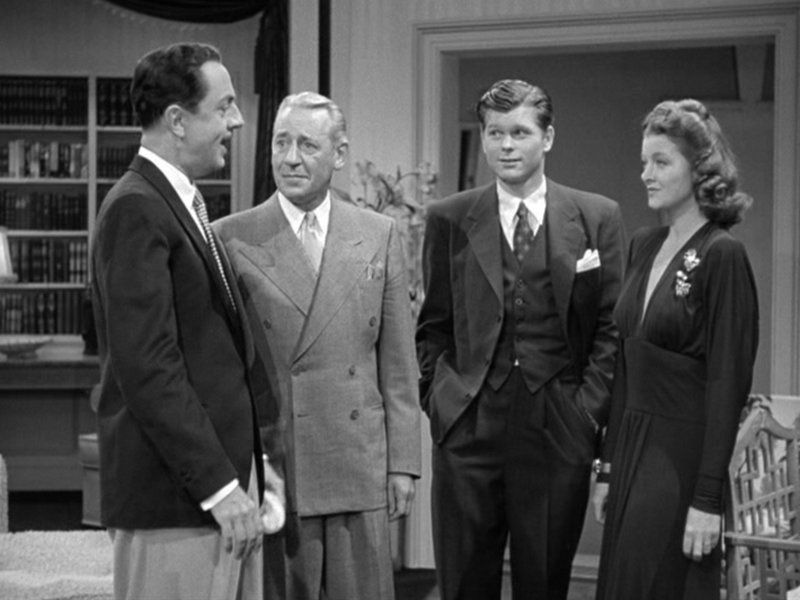Shadow of the Thin Man (1941)
- Soames Inscker

- Jun 17
- 4 min read

Shadow of the Thin Man (1941) is the fourth installment in MGM’s popular "Thin Man" series, which follows the charming and witty detective duo Nick and Nora Charles, played to perfection by William Powell and Myrna Loy. Building on the legacy of its predecessors, Shadow of the Thin Man stays true to the franchise's signature blend of sophisticated banter, light-hearted domestic comedy, and a murder mystery set in an urbane world of cocktails, gangsters, and society dames.
Directed once again by the reliable W.S. Van Dyke—nicknamed "One-Take Woody" for his fast, economical directing style—the film retains much of the series’ familiar tone, while subtly reflecting the early 1940s zeitgeist. Although it doesn't quite reach the originality and freshness of The Thin Man (1934), this entry remains a polished and entertaining sequel, bolstered by the enduring chemistry between its two leads.
Plot Summary
The story opens with Nick and Nora Charles living a comfortably domestic life in San Francisco, raising their son, Nicky Jr., and their faithful dog, Asta. Despite Nick’s best intentions to stay away from crime-solving, he is quickly pulled into a murder investigation at a local racetrack. A jockey with a shady past is found dead under suspicious circumstances, and as usual, the police seek Nick’s insight.
As the plot unfolds, the murder appears connected to a larger web involving gambling rackets, corrupt sports promoters, and a cynical journalist. With the help of Nora (ever eager to share in her husband’s sleuthing escapades), Nick delves deeper into the criminal underworld. The investigation leads them from racetracks to high-end restaurants, seedy nightclubs, and newspaper offices, all while peppered with social satire and breezy repartee.
Among the supporting players are Barry Nelson as a journalist friend of Nick's, Donna Reed in an early role as a sweet-natured secretary caught up in the mystery, and Sam Levene as the perpetually exasperated police lieutenant Abrams, who is trying to manage the case (and Nick’s irreverent input) with some level of control.
Performance and Characterization

William Powell and Myrna Loy once again prove why they were one of Hollywood’s most beloved screen pairs. Powell’s Nick Charles is still suave, debonair, and quick-witted—his charm only deepened by a paternal streak that adds warmth to the character. Loy's Nora is as elegant and sharp as ever, serving as Nick’s partner in both life and sleuthing. Their on-screen relationship is a perfect marriage of equals—sophisticated yet playful—and remains a high point of the series.
Their ability to maintain sparkling chemistry without descending into cliché or sentimentality is no small feat, particularly in a film series that by this point could have begun to feel formulaic. Instead, their interactions remain fresh, often stealing the show from the central mystery.
Sam Levene, who replaces the previous detective characters with his own brand of gruff humour, brings a new dynamic to the investigative trio. Donna Reed, while underused, is appealing in her small role and hints at the major star she would soon become.
Direction and Cinematography
W.S. Van Dyke’s brisk direction keeps the film moving at an efficient clip. Though Shadow of the Thin Man is more plot-heavy than some previous entries, Van Dyke ensures that the pacing never drags. The film benefits from polished cinematography by William H. Daniels, who lends a crisp, clean look to the black-and-white imagery, favouring soft lighting and glamorous close-ups that highlight Loy’s radiant screen presence.
The action scenes, though few, are capably handled, while the film’s strongest set-pieces revolve around witty dialogue exchanges and domestic interludes, such as Nick struggling to avoid being drawn into the case or trying to keep up with Nora’s pointed curiosity.
Themes and Tone

Like the earlier Thin Man films, Shadow of the Thin Man continues to juxtapose high society elegance with seedy crime, making light of the often corrupt and contradictory forces within American life. This installment lightly critiques journalism, gambling, and professional sports, though its satire is gentle, never veering into darkness.
The film also reflects the shifting cultural mood of early 1940s America. The frivolity of the pre-war 1930s is slowly giving way to more grounded, socially-aware storytelling, but Shadow retains its comedic buoyancy, opting for levity over noir-style intensity.
Interestingly, Nick and Nora’s child, Nicky Jr., is given more attention in this film, suggesting a nod toward the post-Depression emphasis on family values. However, the film wisely keeps the tone light, avoiding sentimentality even when depicting domestic life.
Legacy and Conclusion
While Shadow of the Thin Man does not surpass the brilliance of the original or the tight plotting of After the Thin Man, it remains a delightful entry in the series, largely because it sticks to what the franchise does best: elegant stars, light-hearted intrigue, and the charming interplay of a modern, urbane couple who treat crime-solving like an amusing social activity.
This film is perhaps more family-focused and conventional in tone than its predecessors, but it never loses its stylish flair. For fans of classic Hollywood, the "Thin Man" series remains one of the best blends of romantic comedy and detective fiction, and Shadow of the Thin Man proves that even by the fourth round, the formula still had plenty of fizz.
Rating:
A sparkling continuation of the beloved series, sustained by Powell and Loy’s unbeatable chemistry, even if the mystery itself lacks novelty.






